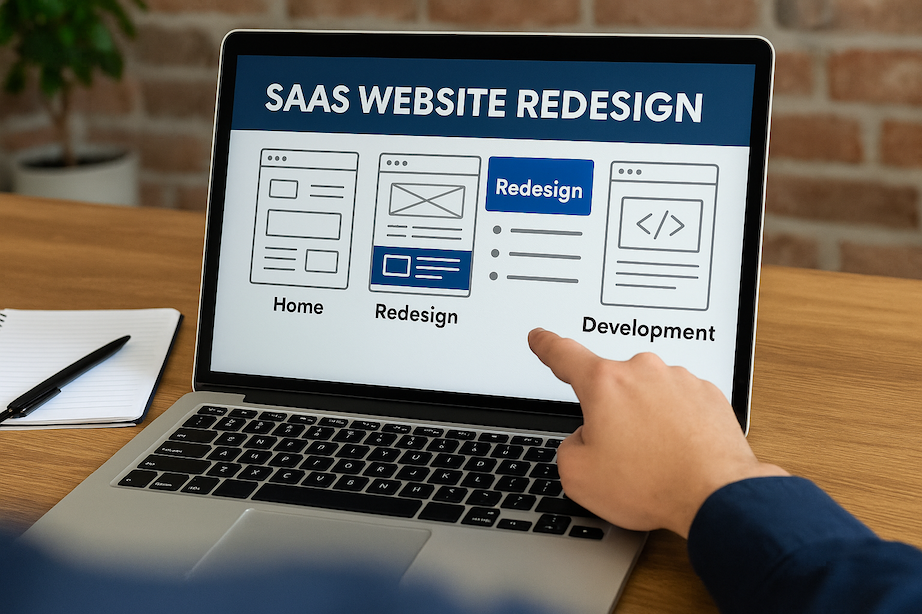Top 10 Webflow Best Practices for B2B Tech Startups

For many B2B tech startups, the website is the first place potential customers, investors, or partners interact with the brand. It is often where people decide whether to schedule a demo, sign up for a trial, or move on.
In fast-moving markets, a website is not just a digital brochure. It plays a direct role in generating leads, creating trust, and communicating value.
This article outlines ten practical Webflow best practices for B2B tech startups in 2025. Before exploring those tactics, it's important to understand why Webflow is relevant to this audience.
Why Webflow matters for B2B tech startups
Webflow is a visual web development platform that allows teams to design, build, and launch websites without writing back-end code. It combines design tools, a content management system (CMS), and hosting into one platform. This setup allows marketers and designers to make changes directly, without waiting on engineering support.
For B2B tech startups, this helps reduce development bottlenecks. In many early-stage companies, engineering teams focus on building the core product. Website updates often fall to the bottom of the priority list. With Webflow, marketing teams can own and deploy changes independently.
Speed-to-market is another reason Webflow is relevant. Startups often need to launch new landing pages, test messaging, or update features quickly. Webflow supports rapid iteration without long development cycles.
According to research from Gartner, B2B buyers review a company's website before making purchase decisions. For startups, delays in improving site content, design, or performance can directly affect pipeline and growth.
Preparing your team for no-code development
When using Webflow, B2B tech startups often adjust how their teams approach website projects. Traditional development workflows usually rely on developers to build and maintain every part of the site. With Webflow, teams use a visual builder that allows designers and marketers to make changes without writing code.
No-code platforms like Webflow allow non-technical contributors to manage layout, content updates, and SEO. This often results in shorter timelines, but only if the team is structured to support it. Here are key roles and responsibilities to consider:
- Design lead: Creates layouts and components inside Webflow
- Content manager: Writes and uploads content into the CMS
- SEO specialist: Manages metadata, URL structure, and schema markup
- Analytics owner: Sets up tracking and monitors key metrics
In smaller teams, individuals may take on multiple roles. Clear ownership helps keep the project focused and organized.
Before building anything in Webflow, define your brand messaging. This gives structure to the site and ensures that copy and design support the same ideas. In B2B, buyers expect clarity about what a product does and who it is for.
A basic messaging framework includes:
- Value proposition
- Differentiators
- Industry positioning
- Target audience description
Optimizing design for conversion-focused B2B experiences
Conversion-centered design focuses on guiding visitors toward specific actions, such as filling out a form or requesting a demo. In B2B tech, this process often involves longer decision cycles, more stakeholders, and higher-stakes purchases than in B2C.
B2B site visitors are often product managers, CTOs, or procurement leads. They are seeking tools to solve business problems. Conversion-focused design helps those users find relevant answers quickly.
Create engaging above-the-fold CTAs
Above-the-fold content is what appears on the screen before scrolling. For B2B sites, this space often includes the headline, subhead, and a call-to-action (CTA). CTAs direct users to take a next step, like viewing a demo or downloading a report.
Common B2B CTA examples include:
- "Request a Demo" — top of funnel
- "Download the Guide" — mid-funnel
- "Start Free Trial" — bottom of funnel
Best practices for CTAs:
- Use high-contrast buttons to separate the CTA from background elements
- Place CTAs near headlines to catch attention immediately
- Use action-oriented language such as "Explore," "View," or "Start"
Leverage minimalist layouts
Minimalist layouts reduce visual clutter and help visitors focus on the content. B2B tech companies often deal with complex messaging, which makes simplicity important in design.
Webflow techniques for minimalist layouts:
- Grid systems allow for predictable alignment of text and images
- Consistent spacing ensures content is not crowded or overwhelming
- Typography hierarchy uses font weight and size to show importance
Minimalist designs support usability by allowing decision-makers to find and understand key information faster.
Use data-backed visual hierarchy
Visual hierarchy is the arrangement of elements on a page to guide the viewer's attention. It helps users understand what to read first, second, and third.
Eye-tracking studies show that users scan pages in patterns, often starting from the top left. B2B tech websites that follow these patterns reduce confusion and increase clarity.
Webflow techniques for visual hierarchy:
- Contrast between background and text to increase readability
- Size differences between headings, subheadings, and body text
- Whitespace around key sections to separate content blocks
Managing content and scaling with Webflow CMS
Webflow CMS is a system for managing content like blog posts, case studies, and product pages. It uses collections, which are groups of similar content with shared structure. Each collection has fields such as title, description, image, or category.
Content modeling is the process of deciding which collections to create and what fields each one will include. For example, a SaaS company might use collections for blog posts, customer stories, features, and pricing plans.
Here are examples of CMS structures for different B2B tech companies:
Company TypeExample CollectionsKey FieldsSaaSBlog Posts, Features, Use CasesTitle, Summary, Feature TagsHardwareProducts, Datasheets, SupportModel Number, Specs, PDF LinkServicesCase Studies, Team, ServicesClient Name, Industry, Project URL
With this setup, a marketing team can publish new articles or update product pages directly in Webflow. No developer is required for day-to-day content edits or launches.
Using consistent collection structures, fields, and taxonomies supports long-term scalability. It also reduces errors and keeps the site organized as the business grows.
Integrating CRM and analytics for lead generation
Webflow can work with tools that B2B tech startups use for sales, marketing, and analytics. This helps teams track leads, measure engagement, and share data between different systems.
Connecting Webflow with a CRM (Customer Relationship Management) platform allows form submissions to go directly into the sales pipeline. It also enables lead scoring and automated follow-ups.
Steps to map form data:
- Create custom fields in the CRM for data like company name, job title, or industry
- Match form fields in Webflow to those custom fields
- Use middleware tools like Zapier to automate the data flow
Webflow can also send data to analytics tools like Google Analytics 4. This helps teams understand how visitors use the site, what content they interact with, and which pages lead to conversions.
Key events to track include:
- Form submissions
- Content downloads
- Product page views
- Pricing page visits
Ensuring speed, SEO, and security
Speed, SEO, and security are core technical elements of a B2B tech website. These factors directly affect how a site performs, how it ranks in search engines, and how trustworthy it appears to technical buyers.
For B2B audiences—such as engineers, IT leads, or procurement managers—slow load times, poor metadata, or missing security signals can reduce credibility.
Compress images and enable lazy loading
Image optimization reduces file size and helps maintain fast page load speeds. Webflow supports several formats and compression techniques designed to improve performance without lowering quality.
- File formats matter: Use WebP or AVIF for product screenshots and UI captures. These formats offer better compression than JPEG or PNG.
- Size limits help: Keep file sizes under 250 KB for full-width images and under 100 KB for inline or icon-style visuals.
- Lazy loading works: Enable this feature in Webflow's image settings panel. It loads images only when they appear on screen.
Use custom meta tags and schema markup
Meta tags and schema markup help search engines understand the content of a page. In Webflow, these can be added manually in the page settings or through custom code embeds.
Custom meta titles and descriptions describe each page clearly using target keywords. Schema markup uses JSON-LD to define the type of content on the page, such as a product, organization, or event.
Common schema types used by B2B tech companies include:
- SoftwareApplication for feature pages and product overviews
- Organization for about pages and leadership pages
- Event for upcoming demos and recorded sessions
Leveraging interactions and animations for product demonstrations
Interactions and animations can help explain how complex B2B tech products work. These features allow visitors to see systems or workflows in motion, rather than reading about them.
In B2B contexts, the goal is to maintain clarity and professionalism. Animations that are too flashy or confusing can distract from the message. However, small interactive elements—like hover effects, progress animations, or step-by-step walkthroughs—can help visitors understand how a product functions.
Webflow includes built-in tools for creating these interactions without writing code. Teams can control timing, movement, and visibility to guide users through content.
Examples of effective B2B animations include:
- Showing a layered diagram of your architecture as each piece fades in while scrolling
- Revealing integration points between your product and third-party tools in steps
- Displaying a user journey from onboarding to activation using scroll-timed panels
Guidelines for subtle animations:
- Keep durations short (200ms to 500ms)
- Apply smooth transitions such as "ease-out" to avoid abrupt stops
- Limit animation to one objective per section (reveal, highlight, or guide)
Scaling global or multi-product sites
As B2B tech startups grow, they often expand into new markets or introduce multiple product lines. This creates challenges for managing brand consistency, organizing complex navigation, and delivering content in different languages.
Webflow offers tools that support scalable design systems, flexible content structures, and localization options.
Style guides help maintain a consistent visual identity across all pages and sections of a site. A style guide includes reusable design elements such as fonts, buttons, and color palettes.
- Global styles maintain consistency: Ensure headings, links, and buttons look the same site-wide
- Symbols save time: Create shared components like nav bars or footers using Webflow Symbols
- Clear naming helps teams: Name classes clearly (e.g., .button-primary, .text-body) to make reuse easier
Flexible navigation structures reduce friction for users and keep the site manageable as the business grows. Options include dropdown menus for organizing features, solutions, or regions, and mega menus for large product catalogs.
For companies expanding globally, Webflow Localization allows teams to create separate language versions using content overrides to swap text, links, or images by region.
Future trends: AI and no-code advancements
As of mid-2025, several trends are shaping how B2B tech startups use Webflow. These include artificial intelligence integration, advanced personalization tools, and new no-code development workflows.
AI tools are becoming more common in Webflow's platform. These tools assist with tasks such as writing copy, generating layout suggestions, and analyzing site performance.
Personalization is another area of growth. B2B websites now include more dynamic content based on user behavior, location, or industry. Personalization tools can adapt the messaging, layout, or content of a page depending on who is visiting.
No-code workflows are also expanding. More teams are using shared libraries and visual logic builders to streamline collaboration and automate updates.
Accelerate growth with strategic execution
Webflow allows B2B tech startups to manage their websites visually, without relying on traditional development cycles. A site built with best practices in mind can support lead generation, product education, and sales enablement across multiple teams.
Key takeaways:
- Defined team roles help avoid bottlenecks during builds
- Messaging frameworks ensure consistent positioning across pages
- Content calendars support ongoing engagement through the CMS
- Conversion-focused design enables users to take action quickly
- CRM and analytics integration connects site activity to downstream outcomes
- Speed, SEO, and security practices increase trust and visibility
- Animations and interactions clarify complex product concepts
- Scalable design systems prepare the site for growth and expansion
Max Performance builds Webflow websites for B2B tech companies using a 7–21 day process that includes strategy, copy, design, and development. These sites are structured for growth and built to convert.
Get your free homepage wireframe
FAQs about Webflow best practices for B2B tech startups
How do I ensure compliance with data privacy regulations when using Webflow?
Webflow allows B2B tech startups to manage data privacy by integrating cookie consent banners and adding custom scripts for GDPR/CCPA compliance. Teams can also link to privacy policies and configure form submissions to route data only to approved platforms.
What is the best approach for creating multilingual sites for global B2B tech companies?
Webflow Localization provides a built-in way to serve translated versions of a site with support for hreflang tags and region-specific content. Language variations can be managed directly in the Webflow Designer or through integrations with translation platforms.
Can Webflow support complex product configurators for B2B tech products?
Webflow supports interactive product demos using native interactions and custom JavaScript. For advanced configurators with logic-based outputs or real-time calculations, teams often use third-party embeds or custom code built outside Webflow and integrated via iframe or script.





